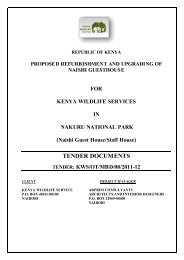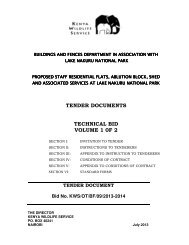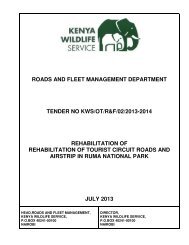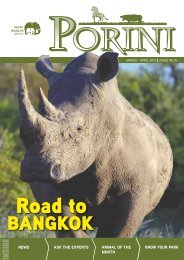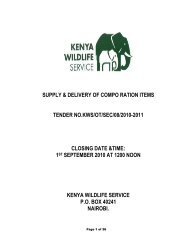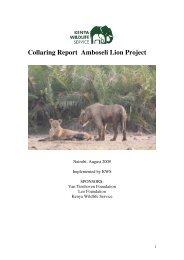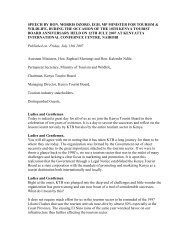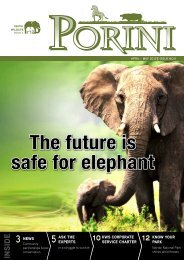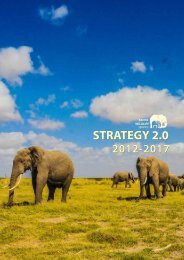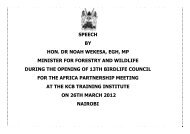Conservation and Management Strategy for the Elephant in Kenya
Conservation and Management Strategy for the Elephant in Kenya
Conservation and Management Strategy for the Elephant in Kenya
Create successful ePaper yourself
Turn your PDF publications into a flip-book with our unique Google optimized e-Paper software.
2 CONSERVATION AND MANAGEMENT STRATEGY FOR THE ELEPHANT IN KENYA<br />
1.1 Status of elephants <strong>in</strong> <strong>Kenya</strong><br />
Two factors have a large effect <strong>in</strong> determ<strong>in</strong><strong>in</strong>g <strong>the</strong> numbers <strong>and</strong> distribution of elephants <strong>in</strong> <strong>Kenya</strong>, <strong>and</strong> elsewhere <strong>in</strong><br />
Africa. These factors are poach<strong>in</strong>g or hunt<strong>in</strong>g, <strong>and</strong> competition <strong>for</strong> or conversion of l<strong>and</strong> by people. As described by<br />
Parker & Graham (1989), <strong>the</strong>re has been a steady decrease <strong>in</strong> elephant habitat over many decades throughout Africa<br />
wherever human populations have <strong>in</strong>creased. They proposed a l<strong>in</strong>ear, negative relationship between human <strong>and</strong><br />
elephant density. Hoare & du Toit (1999), work<strong>in</strong>g <strong>in</strong> rural Zimbabwe, ref<strong>in</strong>ed this model by not<strong>in</strong>g that<br />
coexistence is possible at low human densities, while loss of habitat occurs at a critical threshold level of roughly 15<br />
people per km 2 . The progressive loss of habitat, <strong>and</strong> loss of l<strong>in</strong>ks between habitat patches, has gone fur<strong>the</strong>st <strong>in</strong> West<br />
Africa, where most elephants now live <strong>in</strong> unconnected habitat ‘isl<strong>and</strong>s’, <strong>and</strong> <strong>in</strong> South Africa, where most elephant<br />
populations are now isolated beh<strong>in</strong>d fences. In East African savannahs, Sou<strong>the</strong>rn African miombo woodl<strong>and</strong>s <strong>and</strong><br />
Central African <strong>for</strong>ests, habitat areas that were not suitable <strong>for</strong> cultivation have persisted as elephant habitat <strong>for</strong><br />
longer periods, although humans are now encroach<strong>in</strong>g on l<strong>and</strong> <strong>for</strong>merly considered marg<strong>in</strong>al <strong>for</strong> agriculture.<br />
Hunt<strong>in</strong>g can, <strong>and</strong> has been seen to, elim<strong>in</strong>ate elephants from habitat areas, even when human l<strong>and</strong> use would<br />
o<strong>the</strong>rwise allow coexistence. <strong>Elephant</strong>s were effectively eradicated from large areas of Africa dur<strong>in</strong>g <strong>the</strong> <strong>in</strong>tensive<br />
ivory trade of <strong>the</strong> 18th <strong>and</strong> particularly late 19th centuries (Sp<strong>in</strong>age, 1973), when ivory exploitation was often<br />
comb<strong>in</strong>ed with <strong>the</strong> trade <strong>in</strong> human slaves. The elephant populations of <strong>the</strong> mid-20th century were <strong>in</strong> recovery from<br />
this massive depletion, erupt<strong>in</strong>g <strong>in</strong>to woodl<strong>and</strong> habitats that had grown up <strong>in</strong> <strong>the</strong> absence of elephants (Skarpe et<br />
al., 2004). At this time <strong>in</strong> East Africa, a number of perceived ‘elephant problems’ were encountered, with populations<br />
reportedly <strong>in</strong>creas<strong>in</strong>g unprecedentedly <strong>in</strong> protected areas (PAs) (e.g. Tsavo National Park (NP), as reported by Glover<br />
(1963) among many o<strong>the</strong>rs). Hunt<strong>in</strong>g <strong>for</strong> <strong>the</strong> ivory trade began <strong>in</strong>creas<strong>in</strong>g aga<strong>in</strong> dur<strong>in</strong>g <strong>the</strong> 1970s <strong>and</strong> this was<br />
ano<strong>the</strong>r factor that caused <strong>the</strong> population <strong>in</strong>crease apparent with<strong>in</strong> PAs, as elephants detected <strong>the</strong> danger from<br />
people, sought <strong>the</strong> safety of sanctuaries <strong>and</strong> <strong>in</strong>creased local population densities.<br />
The <strong>in</strong>ternational trade <strong>in</strong> ivory, which had been <strong>in</strong>creas<strong>in</strong>g towards <strong>the</strong> end of <strong>the</strong> 1960s, accelerated dramatically<br />
due to a large illegal component dur<strong>in</strong>g <strong>the</strong> 1970s <strong>and</strong> 1980s, lead<strong>in</strong>g to rapid decl<strong>in</strong>es <strong>in</strong> elephant populations<br />
across West, Central, East <strong>and</strong> parts of Sou<strong>the</strong>rn Africa. Between 1973 <strong>and</strong> 1990, elephant numbers <strong>in</strong> <strong>Kenya</strong><br />
catastrophically dropped from some 167,000 to a m<strong>in</strong>imum of around 20,000 (Douglas-Hamilton, 1989; Joyce Poole,<br />
pers. comm., 2010). From 1990, after <strong>the</strong> <strong>for</strong>mation of a more effective management authority, <strong>the</strong> <strong>Kenya</strong> Wildlife<br />
Service (KWS) <strong>and</strong> <strong>the</strong> end of legal <strong>in</strong>ternational ivory trade (through elevation of African elephants to Appendix I<br />
of CITES), <strong>the</strong> national elephant population gradually <strong>in</strong>creased to about 35,000 <strong>in</strong> 2010, accord<strong>in</strong>g to KWS <strong>in</strong>ternal<br />
estimates.<br />
S<strong>in</strong>ce <strong>the</strong> <strong>in</strong>itial drop <strong>in</strong> ivory sales <strong>and</strong> markets after <strong>the</strong> ban <strong>in</strong> 1989, <strong>the</strong>re have been fluctuations <strong>in</strong> <strong>the</strong> trade.<br />
However, <strong>in</strong> <strong>the</strong> first decade of <strong>the</strong> new century, <strong>the</strong>re was a rise <strong>in</strong> <strong>the</strong> price of ivory, co<strong>in</strong>cid<strong>in</strong>g with an <strong>in</strong>crease <strong>in</strong><br />
ivory dem<strong>and</strong> from those with <strong>the</strong> desire <strong>for</strong> it <strong>and</strong> with <strong>the</strong> economic means to obta<strong>in</strong> it (Stiles & Esmond Mart<strong>in</strong>,<br />
2009). Many believe <strong>the</strong> down-list<strong>in</strong>g of four Sou<strong>the</strong>rn African elephant populations, along with two legal ‘one-off<br />
sales’ of ivory, have led to a recent dramatic resurgence of poach<strong>in</strong>g <strong>and</strong> illegal trade. In some areas, <strong>the</strong> illegal trade<br />
has been <strong>in</strong>creas<strong>in</strong>g s<strong>in</strong>ce <strong>the</strong> mid-1990s <strong>and</strong> this is associated with <strong>in</strong>creases <strong>in</strong> elephant poach<strong>in</strong>g <strong>in</strong> range states<br />
with low levels of law en<strong>for</strong>cement, corruption <strong>and</strong> political <strong>in</strong>stability (Dubl<strong>in</strong> et al., 1995). This situation has<br />
cont<strong>in</strong>ued with <strong>in</strong>creas<strong>in</strong>g trade pressures on elephant ivory associated with <strong>the</strong> emergence of <strong>the</strong> far eastern<br />
economies.<br />
<strong>Kenya</strong>’s elephants occur <strong>in</strong> both savannahs <strong>and</strong> <strong>for</strong>ests, although all are considered to be <strong>the</strong> savannah subspecies<br />
Loxodonta africana africana. The largest range areas <strong>for</strong> <strong>the</strong> savannah populations are <strong>the</strong> Tsavo ecosystem <strong>and</strong> its<br />
environs, <strong>and</strong> <strong>the</strong> Laikipia-Samburu ecosystem <strong>and</strong> contiguous areas to <strong>the</strong> north. The <strong>for</strong>est-dwell<strong>in</strong>g populations<br />
occur ma<strong>in</strong>ly <strong>in</strong> <strong>the</strong> Aberdares <strong>and</strong> Mount <strong>Kenya</strong>, with small, isolated populations <strong>in</strong> coastal <strong>for</strong>ests <strong>and</strong> Mount Elgon.<br />
Some areas of <strong>for</strong>mer range, particularly <strong>in</strong> <strong>the</strong> nor<strong>the</strong>rn parts of <strong>Kenya</strong>, are be<strong>in</strong>g re-occupied as security has<br />
improved. At <strong>the</strong> same time, however, people have occupied many o<strong>the</strong>r areas that were <strong>for</strong>mer elephant range,<br />
through exp<strong>and</strong>ed settlement <strong>and</strong> conversion of rangel<strong>and</strong> to agriculture. There<strong>for</strong>e, elephant habitat range <strong>in</strong> most<br />
parts of <strong>the</strong> country has been reduced while habitat fragmentation <strong>and</strong> l<strong>and</strong>-use conflict has <strong>in</strong>creased.



